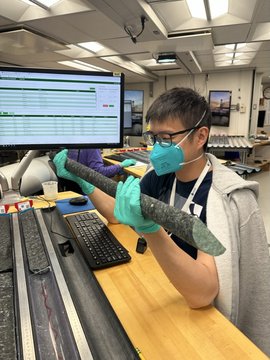Deep drilling allows us to peer far into our planet’s past. From the composition of the material samples, conclusions can be drawn about geological processes, climate, and the emergence of life. Now researchers have collected a core more than a kilometer long from beneath the Mid-Atlantic Ridge in the Atlantic Ocean—longer than any other core ever obtained. As they report in the journal Science, it is largely composed of minerals from the Earth’s mantle.
The Mid-Atlantic Ridge is a special geological area. It stretches across the Atlantic Ocean and is home to a number of unusual formations – including the so-called Atlantis Block. There, rocks from the Earth's mantle lie close to the seafloor.

Drill core inspection
To examine the rock more closely, a research team led by Johan Lissenberg of Cardiff University drilled to record depths. As part of the International Ocean Discovery Program (IODP) Expedition 399, the scientists successfully took a 1,268-metre-long drill core from the Atlantis massif.
Then they analyzed its composition. It turned out that the proportions of different minerals varied greatly. In addition, the proportion of pyroxenes, an important class of rock-forming minerals, was unusually low. According to the researchers, this is probably due to melting processes that occurred when the rocks rose. They also found oxidized material at a depth of 200 meters. Chemical processes must have occurred at some point in time, releasing oxygen.
New drill core could solve more mysteries
In addition to these results, the core of the drill opens up many avenues for further investigation. There is also an unusual hydrothermal field in this area called the Lost City. There, vents up to 60 meters high emit water and methane at temperatures exceeding 120 degrees Celsius, and not acidic fluids at temperatures of up to 350 degrees Celsius, as in underwater volcanic regions. What role such conditions play in the emergence of life and the transition from processes that do not involve life patterns to self-replicating cells is still not understood.
In addition, the seafloor in the Atlantis Block rises by about two centimeters per year. Over millions of years, this ensures that deep rocks eventually rise to the surface. When minerals in the Earth’s mantle come into contact with water, they transform. For example, beneath the seafloor, anhydrous olivine from the Earth’s mantle eventually transforms into serpentine minerals when it interacts with seawater. This in turn changes the environment on the seafloor, which is particularly important for microorganisms.
The new rock samples from the depths could be used to examine in detail different processes beneath the seafloor in the laboratory. This could provide information about how molten rock moves through channels at depth, and thus forms different minerals. The researchers also hope to obtain more drilling samples from other areas to get a more complete picture of what’s happening far beneath the seafloor.

“Total coffee aficionado. Travel buff. Music ninja. Bacon nerd. Beeraholic.”








More Stories
Coral Seeding: Artificial Insemination Makes Coral More Heat Tolerant
Fear, Anger, and Denial: How People Respond to Climate Change – Research
LKH Graz: Using radiation to combat heart arrhythmias